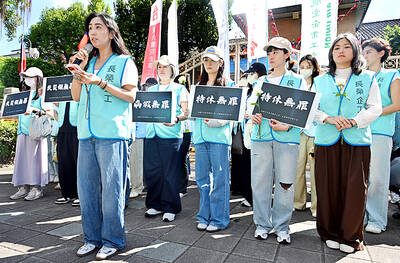The nation’s drive to prevent outbreaks of severe enterovirus will see a breakthrough in September with the start of human clinical trials of a locally developed vaccine against the deadliest type of the virus, EV71, National Cheng Kung University Hospital deputy superintendent Su Ih-jen (蘇益仁) said.
Su, who also headed an EV71 vaccine research team under the National Health Research Institute (NHRI), said his team has overcome a production bottleneck and will be able to release an EV71 vaccine commercially in four months.
Su said the vaccine was developed with EV71-B4 subtype samples provided by the NHRI that were produced into a “seed stock” to form the basis for the vaccine.
The first phase of the clinical trial is scheduled to be launched in September after the Department of Health (DOH) approves the program, Su said, adding that they will be carried out at National Taiwan University Hospital (NTUH) and Taipei Veterans General Hospital, with 30 adults as the trial subjects.
“The main purpose of this stage of the trial is to assess the vaccine’s safety and possible side effects,” Su said, adding that the second and third phases of the trial will focus on observing the vaccine’s efficacy in children.
Once the vaccine passes the human trials, Su said, production can begin in four months, if necessary.
“In other words, the vaccine can be available for an immunization program in January 2011, at the earliest,” Su said.
As EV71 has various strands of viruses prevailing in different areas at different times, Su went on, mass production couldn’t begin until after the vaccine’s specification has been determined.
Citing Centers for Disease Control statistics, Su said the number of cases of EV71 infection accounted for only about 20 percent of the total number of severe enterovirus cases reported between 2000 and 2008.
The figure indicates that children will still have a 70 percent to 80 percent chance of contracting other types of severe enterovirus, Su said.
Given this, he asked how the DOH could convince local parents to get their children vaccinated.
In recent years, Su said, the strands of the EV71 virus prevalent in Taiwan have been B5 and C4, while those commonly seen in other Asian countries are C5 in China, C1, C4 and C5 in Vietnam and B5 in Malaysia.
To meet the demand of local children aged under 3, Taiwan would need to produce 600,000 doses of vaccine, a number Su said is not enough to generate an economy of scale.
Noting that China is also developing an EV71 vaccine, Su said Taiwan should try to use the APEC forum as a platform to develop a vaccine that can be effectively used in enterovirus immunization throughout Asia.
“That way, we could produce up to 20 million doses for sale across Asia to realize an economy of scale,” he said.
Huang Li-min (黃立民), director of NTUH’s pediatric infectious diseases division, added that as there are over 100 strands of the enterovirus, it will not be easy to produce a vaccine capable of preventing all those types of the infection.
Enterovirus vaccines are brand new, he added.
“It would be better to develop a vaccine on the basis of samples of a single type of virus. The issue regarding cross-protection for the various subtypes should be considered at a later stage,” he said.
For the locally developed EV71 vaccine, Huang said, NTUH would not launch a third stage of clinical trials among 5,000 to 10,000 children unless the first and second stages of testing are successful.
“It will also be a challenge to persuade local parents to enroll their children in the trial,” he added.

The Taoyuan Flight Attendants’ Union yesterday vowed to protest at the EVA Air Marathon on Sunday next week should EVA Airway Corp’s management continue to ignore the union’s petition to change rules on employees’ leave of absence system, after a flight attendant reportedly died after working on a long-haul flight while ill. The case has generated public discussion over whether taking personal or sick leave should affect a worker’s performance review. Several union members yesterday protested at the Legislative Yuan, holding white flowers and placards, while shouting: “Life is priceless; requesting leave is not a crime.” “The union is scheduled to meet with

‘UNITED FRONT’ RHETORIC: China’s TAO also plans to hold weekly, instead of biweekly, news conferences because it wants to control the cross-strait discourse, an expert said China’s plan to expand its single-entry visa-on-arrival service to Taiwanese would be of limited interest to Taiwanese and is a feeble attempt by Chinese administrators to demonstrate that they are doing something, the Mainland Affairs Council said yesterday. China’s Taiwan Affairs Office (TAO) spokesman Chen Binhua (陳斌華) said the program aims to facilitate travel to China for Taiwanese compatriots, regardless of whether they are arriving via direct flights or are entering mainland China through Hong Kong, Macau or other countries, and they would be able to apply for a single-entry visa-on-arrival at all eligible entry points in China. The policy aims

Taipei, New Taipei City, Keelung and Taoyuan would issue a decision at 8pm on whether to cancel work and school tomorrow due to forecasted heavy rain, Keelung Mayor Hsieh Kuo-liang (謝國樑) said today. Hsieh told reporters that absent some pressing reason, the four northern cities would announce the decision jointly at 8pm. Keelung is expected to receive between 300mm and 490mm of rain in the period from 2pm today through 2pm tomorrow, Central Weather Administration data showed. Keelung City Government regulations stipulate that school and work can be canceled if rain totals in mountainous or low-elevation areas are forecast to exceed 350mm in

EVA Airways president Sun Chia-ming (孫嘉明) and other senior executives yesterday bowed in apology over the death of a flight attendant, saying the company has begun improving its health-reporting, review and work coordination mechanisms. “We promise to handle this matter with the utmost responsibility to ensure safer and healthier working conditions for all EVA Air employees,” Sun said. The flight attendant, a woman surnamed Sun (孫), died on Friday last week of undisclosed causes shortly after returning from a work assignment in Milan, Italy, the airline said. Chinese-language media reported that the woman fell ill working on a Taipei-to-Milan flight on Sept. 22